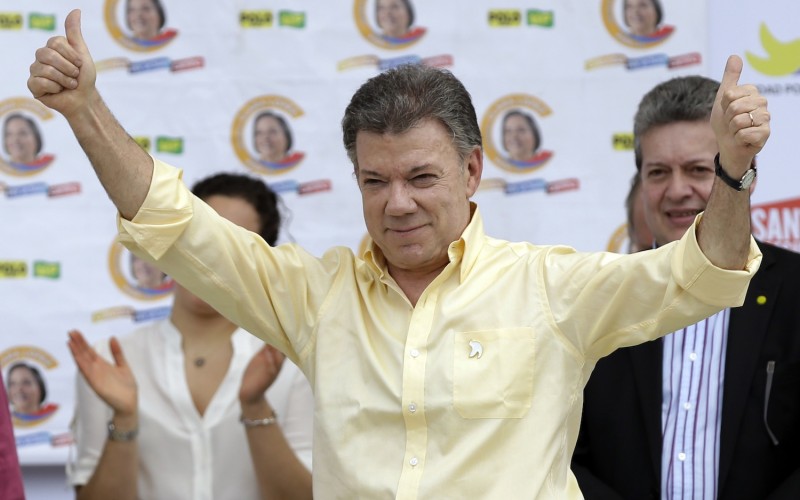The Colombian economy is faltering after years of oil-driven economic bonanza. Now, more than ever, a government-led national discussion to restructure and strengthen strategic import-competing industries is necessary.

In a span of twelve months, the Colombian economy has been rocked. On July 24, 2014, the Colombian peso (COP) was trading at 1,848 COP to the U.S. dollar (USD). Exactly one year later, the peso was trading at 2,861 to the dollar—a 36% depreciation. The massive depreciation of the peso is caused by both external and internal factors and exemplifies the broader structural problems hindering Colombian potential for growth.
Political incentives discouraged the Colombian government from discussing economic reform in the past decade of bonanza. Now, however, slipping national economic output, 9% unemployment, inflation nearing 5%, rising taxes, and a national debt worth 40.06% of GDP have conditioned a proper political environment for creating a national strategy to restructure and diversify Colombia’s economic drivers.
External factors—less demand for commodities
In theory, this market correction should boost Colombian exports and increase the competitiveness of export-oriented industries. Unfortunately, this will not be the case—Colombia exports mainly primary sector commodities, all of which have precipitously dropped in price since July 2014.
The prices of Colombia’s main exports have depreciated significantly in the past year: coffee by 31.2%, coal 32.6%, nickel 43% and gold by 16.2%.
Yet the negative price conditions of these commodities do not affect the Colombian economy nearly as much as the drop in crude oil prices, which accounts for 42.41% of Colombia’s exports. The price of Brent crude oil (ICE)dropped from a $108 high to about $54 per barrel this past year, an almost 50% dip.
The effects of low oil prices are shown by the stock of Ecopetrol, the national oil company (mixed-stock corporation), which has plummeted from 3,215 COP to 1,585 COP, or a 50.7% drop. The balance of trade has markedly deteriorated, with exports decreasing from 5.5 billion USD in May 2014 to 3.35 billion USD in May 2015. Overall, exports in 2015 have contracted 31% and imports have contracted 10%.
Internal factors—falling state revenues, increasing debt, and added taxes
Not surprisingly, the Colombian government’s credit improved in the past decade of high growth, allowing the national and local governments to borrow funds for infrastructure development projects. From 2006 to 2014, the Colombian national debt increased to $53.5 billion (roughly 40% of GDP).
Now the national and local governments are expected to continue repaying its dollar-denominated loans with shrinking peso-denominated revenues (91.2% of Colombia’s debt is dollar-denominated)—a disastrous combination considering the unfavorable foreign exchange and export conditions.
The deteriorating fiscal situation of Colombia’s national government is inflamed by falling revenues in dominant industries i.e., oil and mining; as well as a highly inefficient and uncompetitive industrial sector, which posted a $14.27 billion dollar trade deficit in the first 2 quarters of 2015.
As a response to the revenue shortfall, the Colombian government introduced a “tax on wealth” for corporations and individuals, regardless of falling international and local investment. As expected, the tax has not been well received by the business community.
The country’s most prominent business association (ANDI) has officially requested the government to rethink its new tax rates, claiming that it has placed an unbearable strain on the country’s 3,500 biggest companies andhindered private sector competitiveness.
A path forward
With president Juan Manuel Santos’ approval rating at 22% and three years left on his final term in office, the political situation is now ripe for the Colombian government to initiate a genuine discussion on economic reform that is centered on a transformation to develop strategic industries. The Colombian economy is too dependent on the international demand for commodities and has little advanced industry.
The national conversation on an economic transformation should be based on creating export-oriented, high-value-added industries that rely on skilled human capital. The office of the President should take on a corporative governance model and provide incentives to local governments by initiating transparent public-private partnerships focused on improving the country’s infrastructure, specifically inter-city highways and urban transportation grids.
Moreover, if Colombia is to become a regional leader in high-tech value-added industries, it needs a well-trained work force. As of February 2015, Colombian schools were ranked the 4th worst globally in mathematics and the 6th worst in science.
Finally, the national government can ease regulations for renewable energy projects and court international companies in this burgeoning sector. In 2014, the government issued a decree introducing a modest tax subsidy for companies investing in renewable energy sources. Although the established tax subsidies are helpful, they alone are not enough to spur local start-up renewable energy companies.
The government needs to support local renewable energy companies by subsidizing their sales to make sure they meet an established profit margin during the company’s nascent years. Without a more aggressive form of subsidy, renewable energies will not be able to compete with traditional energy suppliers.
The institution with the capacity to take on the proposed initiatives and modernize the country’s economy already exists. The central government’s national development plan (plan nacional de desarrollo) is a three-year partnership between the local and central government as well as the private sector.
Unfortunately, the central government budget figures for 2016 demonstrate that the central government will not meet its funding benchmark for the mentioned development plan. It is necessary that the central government doubles down on its funding commitment and not only meet the proposed benchmark but increase its investment in this institution.
Colombia does not have an easy path forward, considering external market conditions will not improve in the short term. But the governing administration of Juan Manuel Santos has little else to lose – what better time to rethink Colombia’s productive capacity and initiate a broad inter-sector economic transformation.
sourche: http://globalriskinsights.com/2015/07/collapsing-currency-signals-need-for-reform-in-colombia/
Δεν υπάρχουν σχόλια:
Δημοσίευση σχολίου